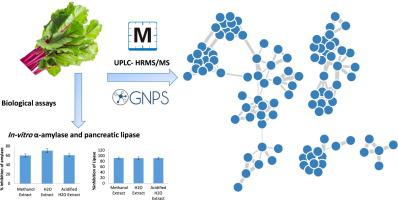Journal of Advanced Research ( IF 11.4 ) Pub Date : 2020-06-03 , DOI: 10.1016/j.jare.2020.06.001 Nesrine M Hegazi 1 , Rasha A Radwan 2 , Sherein M Bakry 1 , Hamada H Saad 1, 3

|
In the present study, the efficiency of three different solvents (H2O, acidified H2O, and 70% Methanol) for metabolites extraction from the leaves of sugar beet (Beta vulgaris subsp. vulgaris var. rubra) was investigated along with their inhibitory activity on pancreatic α-amylase and lipase for obesity management. The metabolic profile of the three extracts was analyzed by ultra-performance liquid chromatography (UPLC) coupled with electrospray ionization high-resolution mass spectrometric (ESI-HRMS-MS). Mass spectrometry-based molecular networking was employed to aid in metabolites annotation and for the visual investigation of the known metabolites and their analogues. The study led to the tentative identification of 45 metabolites including amino acids, purine derivatives, phenolic acids, flavonoids, fatty acids, and an alkaloid, articulating 24 compounds as a first time report from beet leaves along with 2 new putatively identified compounds: a flavone feruloyl conjugate (39) and a malonylated acacetin diglycoside (40). The three extracting systems exhibited comparable efficiency for pulling out the secondary metabolites from the beet leaves. The in vitro study supported this finding and demonstrated that the three extracts inhibited the activity of both pancreatic α-amylase and lipase enzymes with no significant difference observed regarding the percentage of the inhibition of the enzymes. Conclusively, the extraction protocol has a minimal effect on the anti-obesity properties of beet leaves.
中文翻译:

使用三种提取溶剂进行分子网络辅助甜菜叶的代谢组学分析及其抗肥胖作用。
在本研究中,研究了三种不同溶剂(H 2 O、酸化 H 2 O 和 70% 甲醇)从甜菜( Beta vulgaris subsp. vulgaris var. rubra )叶子中提取代谢物的效率及其对胰腺 α-淀粉酶和脂肪酶的抑制活性,用于肥胖管理。通过超高效液相色谱 (UPLC) 结合电喷雾电离高分辨率质谱 (ESI-HRMS-MS) 分析三种提取物的代谢特征。采用基于质谱的分子网络来帮助代谢物注释以及已知代谢物及其类似物的视觉研究。该研究初步鉴定了 45 种代谢物,包括氨基酸、嘌呤衍生物、酚酸、类黄酮、脂肪酸和生物碱,首次从甜菜叶中鉴定出 24 种化合物,以及 2 种新的推定鉴定化合物:一种黄酮阿魏酰缀合物 ( 39 ) 和丙二酸金合欢素二糖苷 ( 40 )。三种提取系统从甜菜叶中提取次生代谢物的效率相当。体外研究支持了这一发现,并证明三种提取物抑制胰腺 α-淀粉酶和脂肪酶的活性,并且在酶的抑制百分比方面没有观察到显着差异。总之,提取方案对甜菜叶的抗肥胖特性影响极小。











































 京公网安备 11010802027423号
京公网安备 11010802027423号